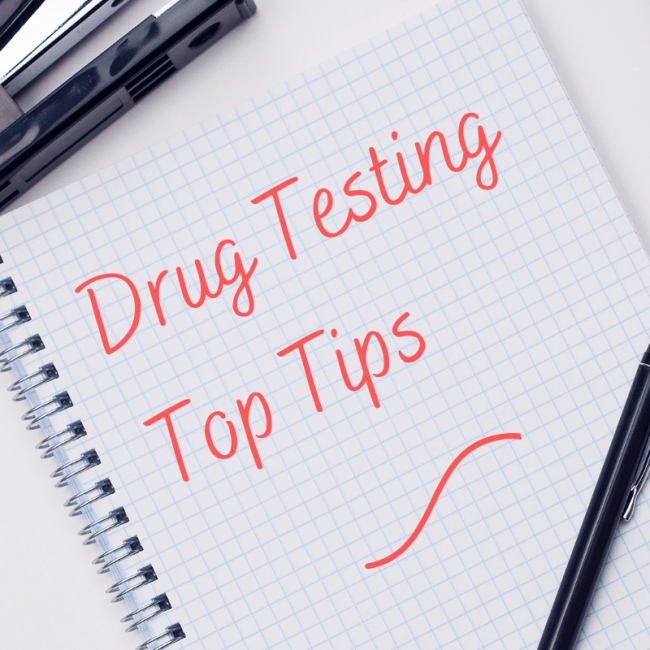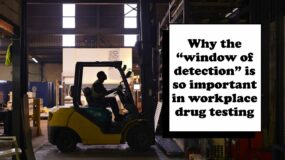Top 10 Tips For Workplace Drug Testing
06.08.2022

Top 10 Tips For Workplace Drug Testing
These days, drug testing is generally accepted as a necessary activity across many sectors, particularly in high-risk industries where safety is paramount, but if you haven’t ever implemented a drug testing programme for your business it can be difficult to know where to begin. Here are our top tips to help you get started:
- First and foremost, ensure your company has an up-to-date Drug and Alcohol Policy that clearly sets out your company’s rules with regard to drug and alcohol use and explains when, where and how testing may take place.
- When implementing a new or updated Drug and Alcohol Policy, involve your staff and managers in the process and make sure employees know where to get support if they have a substance abuse problem themselves, or a concern about a colleague. Some companies have an amnesty period before they begin testing so employees can come forward or seek help in advance if needed.
- Adopt a positive approach towards drug testing. An active Drug and Alcohol Policy demonstrates to employees, contractors and customers that a company takes its corporate responsibilities seriously and cares about the health and safety of its workers and others affected by its business. Testing can also be useful in identifying individuals with mental health issues, enabling support to be offered to employees who might not otherwise have sought help. Choosing a hygienic, modern screening solution like fingerprint drug testing is the most dignified and least intrusive way to implement a testing programme that also aligns with the TUC’s Drug Testing In The Workplace guidance.
- Learn about drug misuse and how to spot the signs of substance abuse. Train your managers and staff so they also know what to look out for in colleagues and promote a culture that supports individuals who may have a drug issue. Encouragingly, according to a 2020 CIPD report, over two-thirds of employers surveyed who have referred employees with drug and/or alcohol problems for specialist support in the past two years, reported that the employee had remained working for the organisation after successfully managing their problem.
- Choose the right drug testing equipment for your business. Having a quick and easy-to-use system that’s always available in-house, and portable for use at remote sites – like 10-minute fingerprint drug testing – is the ideal solution. Employees will be discouraged from using drugs before or during their shift if they know there’s an effective drug testing system on-site which can be brought out at any time for random, for cause or post-incident use. And, if you use drug testing as part of your employee recruitment process, new staff will know from the start that you mean business when it comes to deterring drug use. With an effective in-house testing system, companies can also benefit from significant time, cost and efficiency savings compared with calling in third-party testing services.
- Your employees will need to consent to drug and alcohol tests, so ensure you obtain their written consent prior to testing, using an official consent form for this purpose. Specify in your Drug Policy what happens if an employee refuses to be tested.
- Some prescription medications can affect your employee’s performance and safety at work, and they can also influence drug and alcohol test results. For this reason, ask employees to let you know if they’re taking any medications that could affect their work. Also, ensure staff disclose full details of any medication they have taken prior to carrying out a drug test, noting this down on the drug test consent form. If an individual has a non-negative test result, information about these medications will need to be sent to the laboratory for them to consider when analysing the confirmatory test sample.
- If you suspect drug use by employees or contractors, follow your instincts and investigate without delay. Turning a blind eye to drug use or supply of controlled drugs in your workplace, not only puts people in danger but could also be a criminal offence under health and safety legislation. If you suspect an employee is under the influence at work, carry out a drug screening test there and then.
- If someone refuses to take a test, it may mean they have something to hide but there could also be religious, ethical or medical reasons behind their refusal. If someone does refuse, consult with the employee and balance out your company’s need for testing with their circumstances and act in accordance with your company’s drug policy.
- Remember that drug screening tests are just that. They are convenient, quick and have a high degree of accuracy, but a non-negative screening result will need to be confirmed by a laboratory test and other factors will also need to be considered, such as any medications the person may have taken prior to the test. Companies often employ a Medical Officer to determine which actions to take after an employee screens non-negative, but a laboratory confirmation test is usually the first step.
It can be hard to know where to begin when implementing a drug testing programme for your organisation, or when reviewing your current approach. If you need help to get started, please get in touch and one of our expert team will be very happy to support you.
Useful Resources:
CIPD – (2020) Guidance for managing drug and alcohol misuse at work
Information Commissioner – Employment Practices Code
TUC – (2019) Drugs and alcohol in the workplace: guidance for workplace representatives
Health and Safety Executive – Managing drug and alcohol misuse at work
Talk to FRANK – Website containing easy to understand, detailed information on drugs



